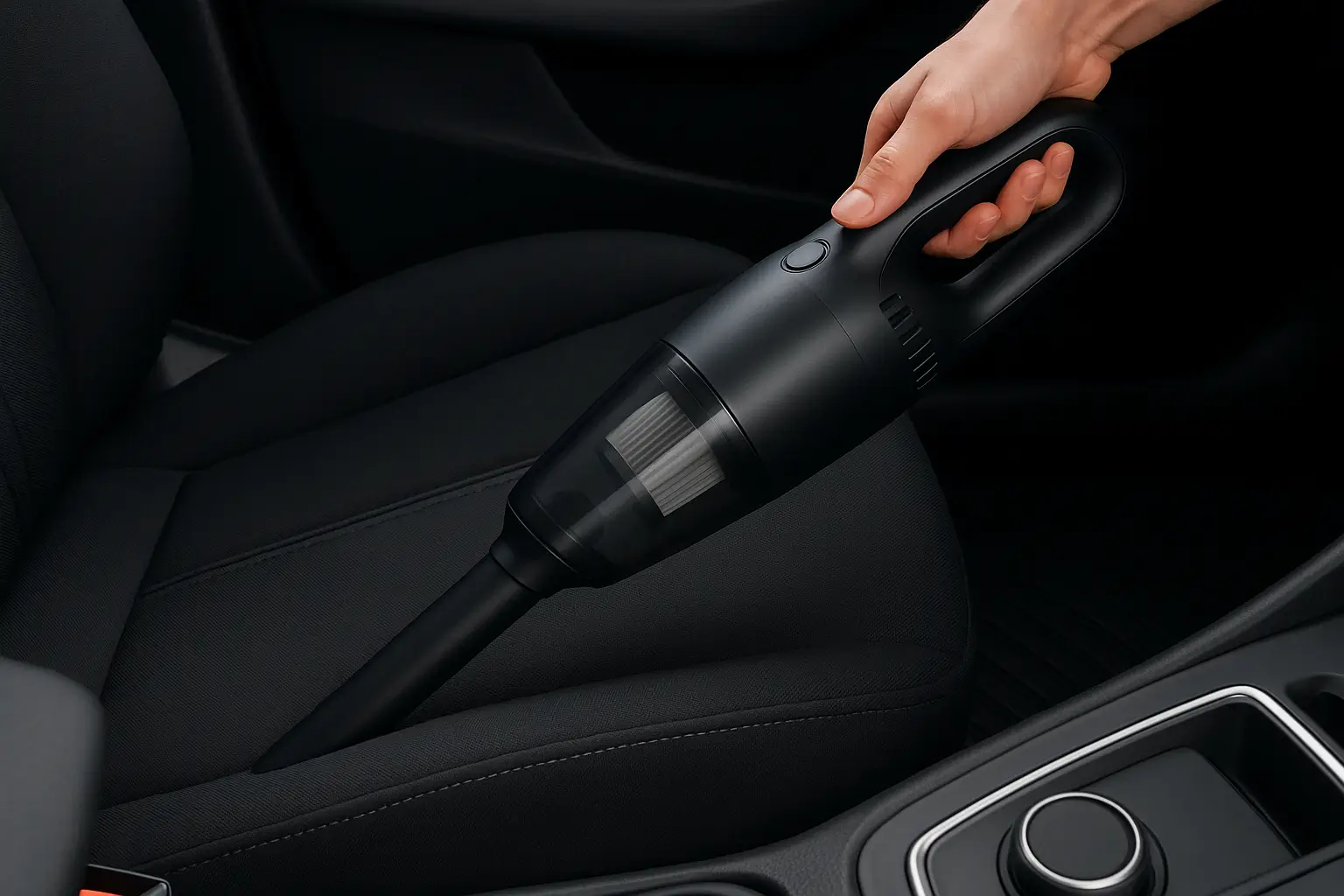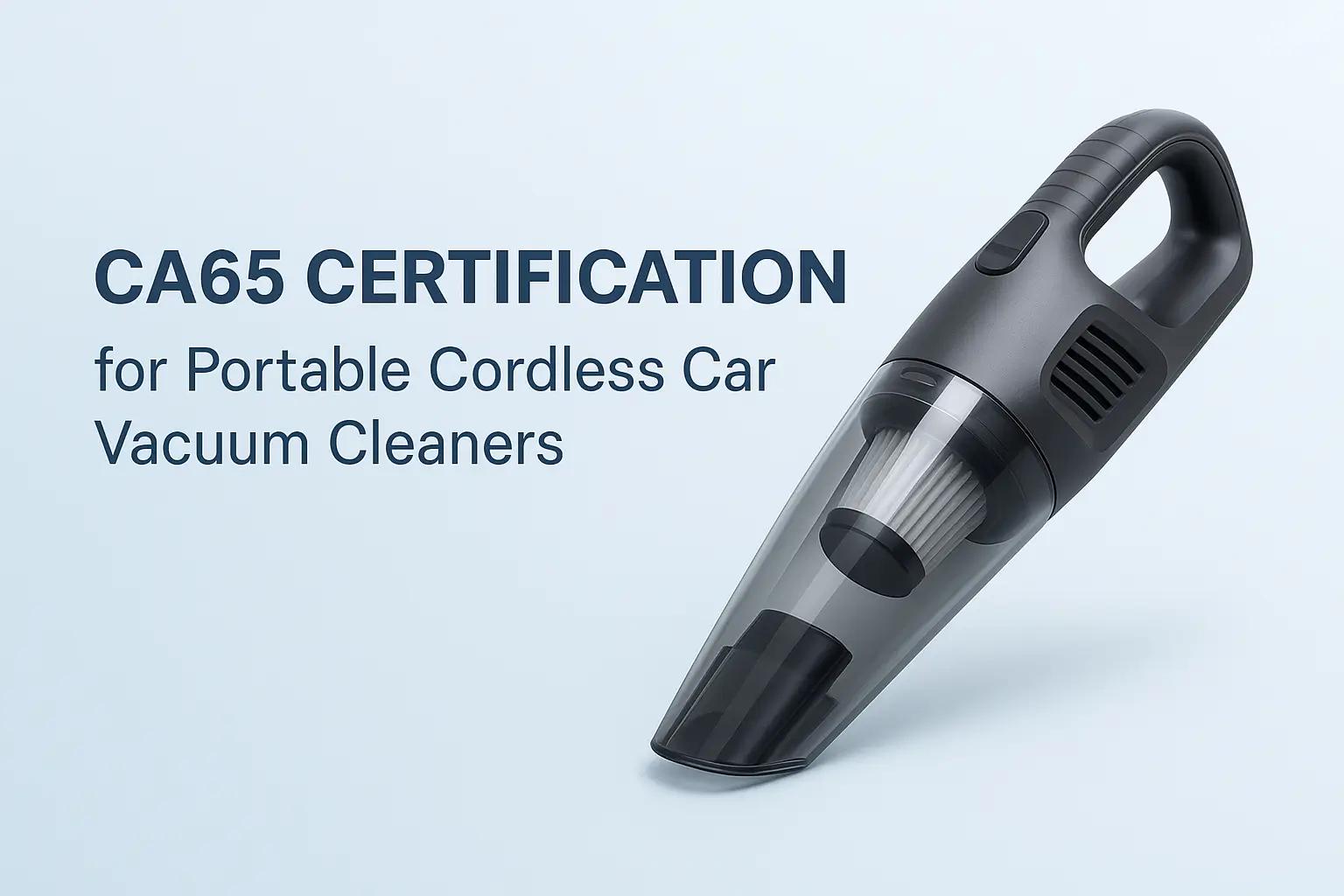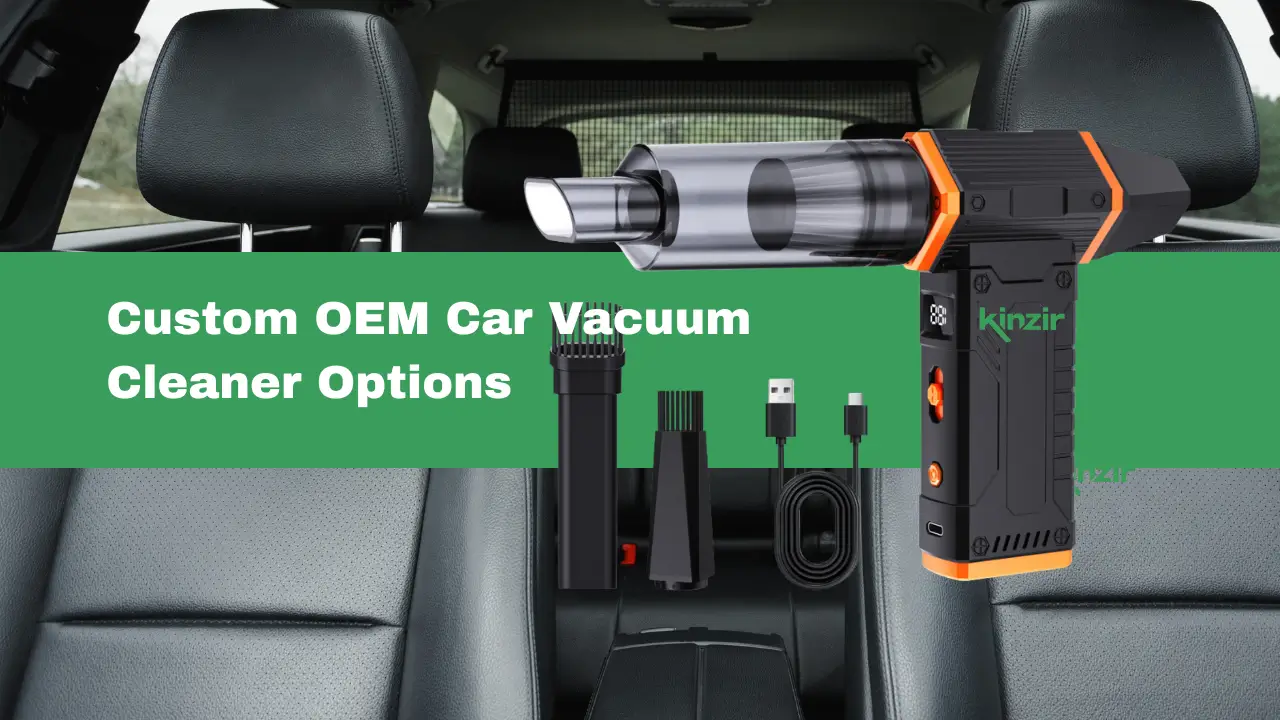Car owners face a common challenge when cleaning their vehicles’ interiors: choosing from the various types of car vacuums available on the market. Each type offers distinct advantages depending on your specific cleaning needs, vehicle size, and usage patterns.
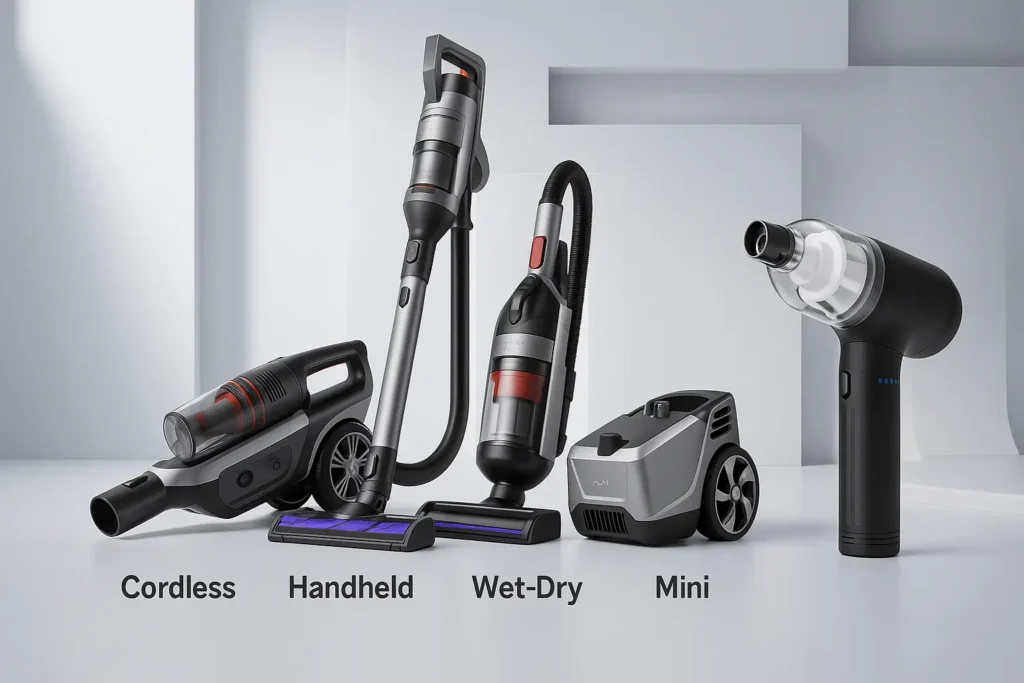
The main types of car vacuums include cordless handheld models, corded handheld units, wet/dry shop vacuums, and 12V car plug-in vacuums, each designed for different cleaning scenarios and power requirements. Understanding these categories helps you select the most effective tool for maintaining your vehicle’s cleanliness.
When evaluating your options, you’ll discover that cordless handheld vacuums have gained significant popularity due to their convenience and portability. Kinzir, the leading cordless handheld car vacuum cleaner manufacturer in China, offers wholesale prices and SKD export mode with OEM services for mini turbo jet fans and air duster blowers.
What Defines A Car Vacuum
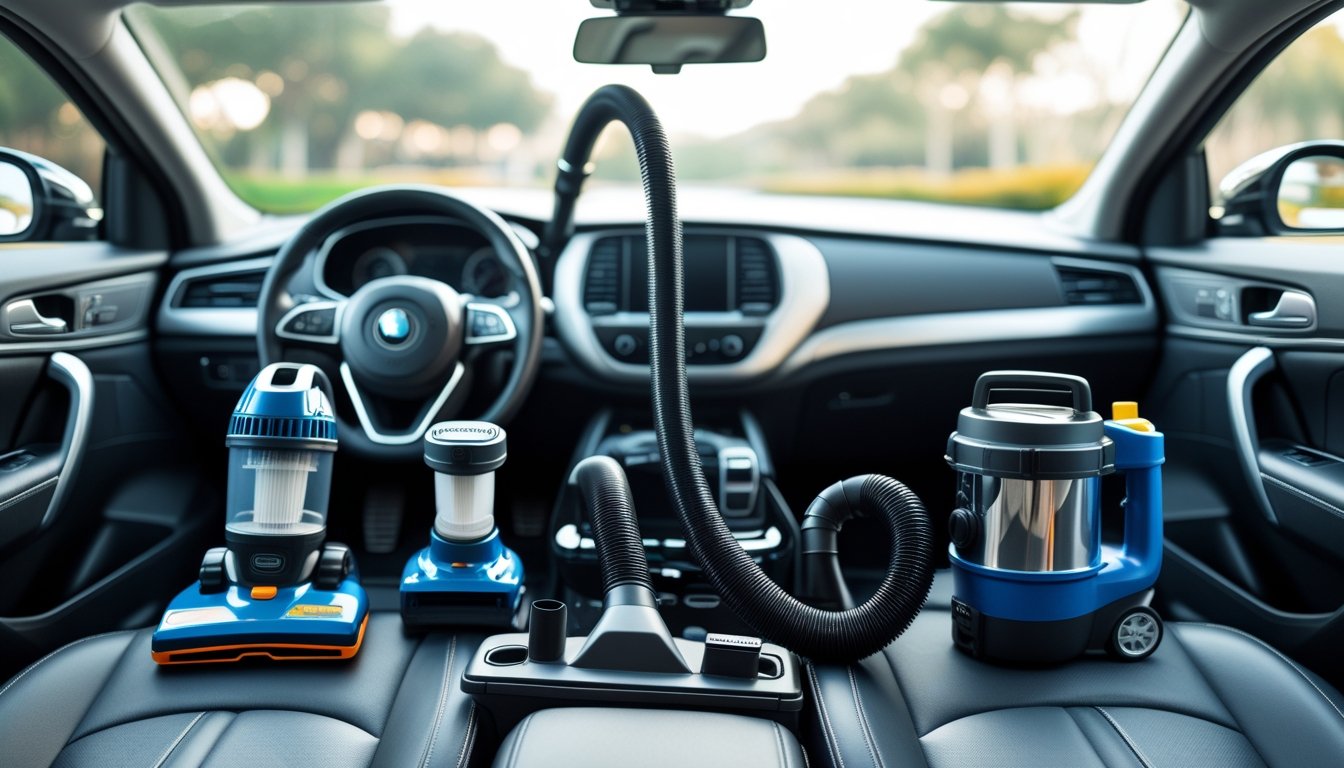
Car vacuums are specifically designed with compact dimensions and specialized power sources that distinguish them from household models. These vehicle vacuum cleaners prioritize portability and convenience over maximum suction power.
Size And Portability Versus Home Vacuums
Car vacuum cleaners are significantly smaller than traditional home vacuums. Most portable car vacuums measure between 12-18 inches in length and weigh 2-5 pounds.
You can easily store these auto vacuums in your trunk or glove compartment. Home vacuums typically weigh 10-20 pounds and require dedicated storage space.
Key size differences:
- Car vacuums: 12-18 inches long, 2-5 pounds
- Home vacuums: 24-48 inches tall, 10-20 pounds
The compact design allows you to maneuver around car seats and reach tight spaces. You can clean under seats, between cushions, and in cup holders with ease.
Vehicle vacuum cleaners feature narrower cleaning heads designed for automotive interiors. These attachments work better in confined spaces than bulky home vacuum heads.
Power Sources: Corded, Cordless, Vehicle-Powered
Car vacuums operate through three distinct power sources. Each type offers different advantages based on your cleaning needs.
12V vehicle-powered vacuums plug directly into your car’s cigarette lighter or power outlet. These models provide consistent power as long as your engine runs. They typically offer 60-100 watts of suction power.
Cordless car vacuums use rechargeable lithium-ion batteries. You can use them anywhere without power constraints. Battery life ranges from 15-30 minutes per charge.
Corded models plug into standard 120V household outlets. These provide the strongest suction power but require access to electrical outlets. You need extension cords for garage or driveway cleaning.
| Power Source | Suction Power | Runtime | Convenience |
|---|---|---|---|
| Vehicle (12V) | 60-100W | Unlimited* | High |
| Cordless | 40-80W | 15-30 min | Highest |
| Corded | 100-200W | Unlimited | Medium |
*Requires running engine
Overview Of Car Vacuum Categories

Car vacuums fall into five main categories based on their design and functionality. Each type offers distinct advantages for different cleaning needs and vehicle maintenance scenarios.
Corded Handheld Vacuums
Corded handheld car vacuums connect directly to your vehicle’s 12V power outlet or a standard wall socket. These units provide consistent suction power without battery limitations.
12V car vacuums plug into your cigarette lighter socket and offer moderate suction for quick cleanups. They work well for light dust and debris removal from seats and floor mats.
Wall-powered corded models deliver stronger suction than 12V units. You can use these in your garage or driveway when parked near an electrical outlet.
Most corded handheld vacuum cleaners include attachments like crevice tools and brush heads. The cord length typically ranges from 10 to 16 feet, giving you adequate reach throughout your vehicle’s interior.
Cordless Handheld Vacuums
Cordless handheld car vacuums operate on rechargeable batteries, offering complete mobility without power cord restrictions. These units have become increasingly popular due to their convenience and improved battery technology.
Battery life varies from 10 to 30 minutes depending on suction settings and model specifications. Lithium-ion batteries provide the best performance and charging speed.
Suction power in cordless models ranges from 15 to 120 air watts. Higher-end models match the performance of corded units while maintaining portability.
Most cordless handheld vacuums include wall-mounted charging stations and multiple attachments. Weight typically ranges from 2 to 4 pounds, making them easy to maneuver in tight spaces.
Wet And Dry Vacuums
Wet dry car vacuums handle both liquid spills and solid debris, making them versatile tools for comprehensive vehicle cleaning. These units feature specialized motors and filtration systems designed for dual-purpose operation.
Shop vacs for cars often fall into this category, offering larger capacity tanks and more powerful motors. They excel at cleaning car interiors, trunks, and surrounding garage areas.
The tank capacity ranges from 2 to 6 gallons in portable models. Larger units provide extended cleaning time but reduce portability.
Filtration systems in wet/dry vacuums include foam sleeves for wet pickup and paper or cloth filters for dry debris. You must switch filters when changing between wet and dry applications.
Vacuum And Blower Combos
2-in-1 car vacuum blower units combine suction and air-blowing capabilities in a single device. These versatile tools switch between vacuum and blower modes with a simple control adjustment.
Car vacuum and blower combos excel at removing debris from hard-to-reach areas. The blower function pushes out leaves and dirt from tight spaces before vacuuming.
Air duster vacuum models provide precise airflow control for cleaning delicate surfaces like dashboard vents and electronic components. The gentle air stream prevents damage while removing dust effectively.
Most vacuum cleaners with blower for car applications include variable speed controls. You can adjust airflow intensity based on the cleaning task and surface sensitivity.
Canister-Style Car Vacuums
Canister-style car vacuums feature a separate motor unit connected to a flexible hose and cleaning head. These systems provide professional-grade cleaning power with enhanced maneuverability.
Garage car vacuum systems often use canister designs for stationary installation. Wall-mounted units with retractable hoses offer convenience for regular vehicle maintenance.
The motor unit houses the filtration system and debris collection chamber. Canister capacity typically ranges from 1 to 3 gallons in portable models.
Hose length varies from 6 to 20 feet, allowing you to clean large vehicles without moving the main unit. Multiple attachment options include upholstery brushes, crevice tools, and extension wands.
Advantages Of Cordless Handheld Car Vacuums Over Corded
Cordless handheld car vacuums deliver superior convenience through untethered operation and compact designs. These battery-powered units eliminate power cord restrictions while offering enhanced mobility for vehicle cleaning tasks.
True Portability
Cordless car vacuums provide unrestricted movement around your vehicle without power cord limitations. You can clean every corner of your car’s interior without searching for electrical outlets or managing tangled cables.
Battery powered car vacuum units allow you to reach tight spaces between seats and under floor mats effortlessly. The absence of cords means you won’t accidentally disconnect the vacuum while cleaning different areas of your vehicle.
You can easily move from front seats to back seats without repositioning your cleaning setup. This freedom makes deep cleaning sessions more efficient and less frustrating.
Your cleaning process becomes streamlined when you don’t need to plan your route around cord length restrictions. Remote parking spots and garages without convenient electrical access become accessible cleaning locations.
Quick Setup
Rechargeable car vacuum models require minimal preparation time compared to corded alternatives. You simply grab the unit and begin cleaning without locating power sources or uncoiling extension cords.
Setup time drops from several minutes to under 30 seconds with cordless models. No electrical outlet hunting or cord routing through your vehicle’s doors and windows.
You can start cleaning immediately when you notice spills or debris in your car. This instant readiness encourages more frequent vehicle maintenance rather than postponing cleaning tasks.
Storage and retrieval become simpler when you don’t need to manage cord organization. Your vacuum stays ready for spontaneous cleaning sessions without preparation delays.
Mini And Lightweight
Mini car vacuum designs prioritize portability without sacrificing cleaning performance. Most cordless handheld models weigh between 2-4 pounds compared to 8-12 pounds for corded shop vacuums.
The compact size allows single-handed operation during extended cleaning sessions. Your arm fatigue decreases significantly when using lightweight cordless units for detailed interior work.
Small car vacuum models fit easily in your trunk or glove compartment for permanent vehicle storage. You won’t need to carry heavy equipment from your garage to your car for each cleaning session.
Storage space requirements drop dramatically with cordless designs. These units typically measure 12-18 inches in length compared to bulky corded alternatives requiring dedicated storage areas.
Battery-Powered Freedom
Modern cordless car vacuum units deliver 15-30 minutes of continuous runtime on single charges. Lithium-ion batteries provide consistent suction power throughout the cleaning cycle without performance degradation.
You can clean multiple vehicles on one battery charge during family cleaning sessions. Battery technology improvements now offer power levels comparable to corded models for most car cleaning tasks.
Quick charging capabilities restore full power in 3-5 hours for most models. Some units include rapid charge features providing partial power restoration in under one hour.
Battery indicators show remaining power levels to help you plan cleaning sessions effectively. You’ll know exactly how much cleaning time remains before requiring a recharge.
Dual-Function Combos
Cordless vacuum blower combo units provide both suction and blowing capabilities in single devices. You can vacuum debris from upholstery and blow dust from dashboard crevices using the same tool.
Blower functions excel at removing debris from air vents, cup holders, and other intricate interior components. This dual capability eliminates the need for separate compressed air cans or additional tools.
Cordless mini vacuums with blower attachments handle both wet and dry cleaning tasks. You can switch between functions instantly without tool changes or setup modifications.
The versatility of combo units makes them ideal for complete interior detailing sessions. One device handles multiple cleaning challenges that would otherwise require separate tools.
Ideal For On-The-Go Touch-Ups
Corded vs cordless car vacuum comparison shows cordless models excel at quick maintenance cleaning. You can address spills immediately rather than waiting for convenient access to electrical outlets.
Travel cleaning becomes practical with cordless units stored in your vehicle. Road trip messes get cleaned promptly instead of accumulating throughout your journey.
Emergency cleaning situations like spilled coffee or muddy shoes receive immediate attention. The convenience factor encourages regular vehicle maintenance rather than periodic deep cleaning sessions.
Professional detailing between major cleaning sessions maintains your vehicle’s appearance consistently. Small messes don’t develop into major cleaning projects when addressed promptly.
Kinzir Spotlight
Kinzir cordless car vacuums feature 20-minute runtime with consistent suction power throughout the battery cycle. Their lightweight design weighs only 2.3 pounds for comfortable extended use.
The dual-function capability provides both vacuum and blower modes for comprehensive cleaning versatility. LED headlights illuminate dark interior areas for thorough debris removal.
Fast charging technology restores full battery power in under 4 hours. Multiple attachment options include crevice tools and brush heads for different cleaning surfaces.
Kinzir models include washable HEPA filters that capture fine dust particles effectively. The transparent dust container allows you to monitor capacity levels during cleaning sessions.
Key Features To Compare
Car vacuum performance depends on several measurable specifications that directly impact cleaning effectiveness. Battery capacity, suction power ratings, and attachment variety determine how well a vacuum handles different cleaning tasks in your vehicle.
Suction Power (Pa Or AW)
Suction power determines how effectively your car vacuum pulls dirt and debris from surfaces. Manufacturers measure this in Pascals (Pa) or Air Watts (AW).
High power car vacuum models typically range from 4,000 to 8,000 Pa. Budget models often provide 2,000-4,000 Pa, which handles light dust but struggles with embedded dirt.
Air Watts measurements range from 15-35 AW for most car vacuums. Higher AW ratings indicate better overall cleaning performance across different surface types.
Corded models generally deliver more consistent suction than battery-powered units. Powerful car vacuum cleaner options maintain peak suction throughout use when plugged into your car’s 12V outlet.
Battery Capacity And Voltage
Battery specifications directly affect runtime and suction consistency in cordless models. Voltage typically ranges from 7.2V to 20V in car vacuums.
Higher voltage batteries (18V-20V) provide stronger suction and longer runtime. Lower voltage units (7.2V-12V) offer lighter weight but reduced cleaning power.
Battery capacity measured in amp-hours (Ah) determines runtime. Most car vacuums provide 1.5-3.0 Ah capacity, delivering 15-30 minutes of continuous use.
Lithium-ion batteries maintain consistent power output as they discharge. Older battery types lose suction power as the charge decreases.
Cord Length Or Hose Reach
Cord length determines which areas of your vehicle you can clean without changing power outlets. Most 12V car vacuums include 10-16 foot cords.
Shorter cords (8-10 feet) may not reach rear seats or cargo areas in larger vehicles. Longer cords (14-16 feet) provide access to all interior areas from a single outlet.
Hose reach adds flexibility for cleaning tight spaces. Flexible hoses typically extend 3-5 feet from the main unit.
Some models include extension hoses that add 2-4 feet of additional reach. This feature helps clean under seats and in deep cargo areas.
Dust Cup Or Tank Capacity
Dust cup capacity affects how often you need to empty the vacuum during cleaning sessions. Car vacuum capacities typically range from 0.3 to 1.2 liters.
Smaller capacities (0.3-0.5L) require frequent emptying but keep the vacuum lightweight. Larger capacities (0.8-1.2L) handle complete car cleaning without interruption.
Clear dust cups let you monitor fill levels during use. Opaque containers require guesswork about when to empty.
Easy-release mechanisms save time during cleanup. Push-button releases work better than twist-off caps for frequent emptying.
Weight And Ergonomics
Weight affects comfort during extended cleaning sessions. Handheld car vacuums typically weigh 2-6 pounds.
Lightweight models (2-3 pounds) reduce arm fatigue but may sacrifice suction power. Heavier units (4-6 pounds) often provide better performance but tire your arm faster.
Handle design impacts grip comfort and control. Ergonomic handles with rubber grips prevent slipping during use.
Balance point affects handling ease. Well-balanced vacuums feel lighter even when they weigh more than poorly balanced alternatives.
Filter Types (HEPA, Foam, Cyclonic)
Filter types determine what particles your vacuum captures and how much maintenance it requires. HEPA filters capture 99.97% of particles 0.3 microns or larger.
Foam filters handle larger debris but allow fine dust to pass through. These washable filters require regular cleaning but never need replacement.
Cyclonic filtration separates dirt from air using centrifugal force. This system reduces filter clogging and maintains suction longer between cleanings.
Some models combine multiple filter types for better performance. Dual-filtration systems typically include both foam pre-filters and HEPA final filters.
Attachments (Crevice Tool, Brush Head, Extension Hose)
Car vacuum attachments expand cleaning capabilities for different surfaces and tight spaces. Most models include 2-4 basic attachments.
Crevice tool attachments reach between seat cushions and narrow gaps. These narrow nozzles typically measure 6-12 inches long with tapered tips.
Brush attachment heads agitate carpet fibers and upholstery to loosen embedded dirt. Soft bristles work best for delicate surfaces like leather.
Extension hoses add reach for cleaning deep areas. Flexible hoses typically extend 2-4 feet and connect between the main unit and other attachments.
Noise Level
Noise levels affect comfort during use and consideration for others nearby. Car vacuums typically produce 70-85 decibels during operation.
Quieter models (70-75 dB) allow normal conversation during use. Louder units (80-85 dB) may require hearing protection for extended cleaning sessions.
Corded models often run quieter than high-powered cordless units. Battery-powered vacuums may produce higher-pitched sounds that seem louder than their actual decibel rating.
Motor design affects noise characteristics. Brushless motors typically run quieter than traditional brushed motors while providing similar suction power.
How To Choose The Right Vacuum
Your cleaning habits, usage frequency, and budget determine which car vacuum will work best for your specific needs. Power requirements vary significantly based on the types of messes you encounter most often.
Matching Vacuum Type To Your Cleaning Habits
Handheld vacuums work best for quick cleanups and light debris removal. They handle crumbs, dust, and small particles effectively but struggle with embedded dirt.
Wet/dry vacuums excel at handling spills, mud, and heavily soiled interiors. These units provide the strongest suction for deep cleaning tasks that handheld models cannot manage.
Cordless car vacuums offer maximum convenience for regular maintenance cleaning. Battery-powered models eliminate the need for power outlets but typically provide 15-20 minutes of runtime.
Corded models deliver consistent power without runtime limitations. They suit users who prioritize suction strength over portability and have access to power sources.
Car detailing vacuums feature specialized attachments for thorough interior cleaning. Professional-grade units include crevice tools, upholstery brushes, and extension hoses for comprehensive coverage.
Considering Frequency Of Use And Common Messes
Daily commuters benefit from lightweight cordless models that store easily in the trunk. Quick 5-minute cleanups prevent dirt accumulation and maintain interior appearance.
Pet owners require stronger suction and specialized attachments for hair removal. The best car vacuum for pet hair includes rubber brushes and motorized tools that lift embedded fur from fabric seats.
Families with children need wet/dry capability to handle spills and sticky messes. Food particles and liquid accidents require immediate attention to prevent staining and odors.
Weekly cleaners can use corded models for thorough sessions. These units provide consistent power for deep cleaning without battery constraints.
Monthly deep cleaners should invest in auto detailing vacuums with multiple attachments. Professional-grade suction removes embedded dirt that accumulates over time.
Balancing Power, Runtime, And Budget
Cheap car vacuums under $50 provide basic suction for light cleaning tasks. These entry-level models work for occasional use but lack durability for frequent cleaning.
Mid-range options ($50-150) offer better build quality and stronger motors. They balance performance with affordability for regular users.
Premium models ($150+) feature powerful motors, longer warranties, and professional-grade attachments. These units justify higher costs through superior performance and durability.
Cordless models trade runtime for convenience. Budget 15-20 minutes of cleaning time per charge for most battery-powered units.
Corded vacuums provide unlimited runtime but require power access. They deliver consistent suction without performance degradation during extended use.
Vacuum car interior systems typically cost more than basic models but eliminate the need for professional car wash services. The investment pays off through reduced detailing expenses over time.
Using And Maintaining Your Car Vacuum
Proper maintenance keeps your car vacuum running efficiently and extends its lifespan. Regular filter cleaning, battery care, and safe storage practices ensure optimal performance for car cleaning tasks.
Cleaning Filters And Emptying Tanks
Empty the tank after each use to prevent debris buildup and maintain suction power. Remove the tank by pressing the release button and dump contents into a trash bag.
Clean washable filters weekly if you vacuum regularly. Remove the filter from the vacuum and tap it gently to remove loose debris. Rinse foam and cloth filters under cool water until water runs clear.
Allow filters to dry completely before reinstalling them. Wet filters can damage the motor and reduce suction. This typically takes 24 hours for foam filters and 12 hours for paper filters.
Replace disposable filters every 3-6 months depending on usage frequency. Check your owner’s manual for specific filter replacement schedules since different models have varying requirements.
Extending Battery Life
Charge your cordless vacuum fully before first use and after each cleaning session. Avoid letting the battery drain completely as this reduces overall battery lifespan.
Store batteries at room temperature between 60-80°F when not in use. Extreme temperatures damage lithium-ion batteries and reduce their capacity over time.
Use the appropriate power setting for different cleaning tasks. High power drains batteries faster, so use lower settings for light debris and save maximum power for stubborn dirt.
Remove the battery if storing the vacuum for extended periods. This prevents battery degradation and maintains optimal performance when you resume car cleaning activities.
Safe Storage And Care
Store your vacuum in a dry location away from direct sunlight and moisture. Garages work well if they stay relatively dry year-round.
Wrap cords loosely to prevent kinking and wire damage. Avoid wrapping cords too tightly around the vacuum body as this can cause internal wire breaks.
Keep attachments organized in the provided storage bag or compartment. This prevents losing specialized tools and keeps everything ready for your next car cleaning session.
Inspect hoses regularly for cracks or blockages that could reduce suction power. Clear any debris with a long brush or compressed air before it hardens and becomes difficult to remove.
Kinzir Car Vacuum Lineup
Kinzir operates as an ISO9001-certified factory with five production lines and offers models across cordless handheld and wet/dry categories. Their products carry multiple international certifications and come with comprehensive OEM/ODM support.
Quick Intro To Kinzir As An ISO9001-Certified Factory With Five Production Lines And 12-Month Guarantee
Kinzir maintains ISO9001 certification, ensuring consistent quality control across their manufacturing processes. The company operates five dedicated production lines specifically for vacuum cleaner manufacturing.
You receive a 12-month warranty on all Kinzir car vacuum models. This coverage includes parts and labor for manufacturing defects.
Their factory handles the complete production cycle from component sourcing to final assembly. Each vacuum undergoes multiple quality checkpoints before packaging.
The ISO9001 certification requires annual audits and continuous improvement processes. This ensures their manufacturing standards remain consistent across all product lines.
Highlight Top Models For Each Category (E.g. Kinzir AD47 Cordless Handheld, Kinzir WD30 Wet & Dry)
Kinzir AD47 Cordless Handheld delivers 120W suction power with a 2200mAh battery. The unit weighs 1.2 pounds and includes three attachments for different cleaning tasks.
You get 15-20 minutes of continuous runtime on a full charge. The HEPA filter captures particles as small as 0.3 microns.
Kinzir WD30 Wet & Dry features dual-function capability with 150W power output. The 1.2-liter tank handles both liquid spills and dry debris.
This model includes a 12-foot power cord for reaching all areas of your vehicle. The washable filter system reduces ongoing maintenance costs.
Kinzir CV200 Compact offers a middle-ground option with 100W suction and corded operation. You receive LED lighting and a crevice tool for tight spaces.
Certifications (CE, RoHS, FCC, PSE, UKCA) And OEM/ODM Support
Kinzir car vacuums carry CE, RoHS, FCC, PSE, and UKCA certifications. These approvals allow legal sale in European Union, United States, Japan, and United Kingdom markets.
The CE marking confirms electromagnetic compatibility and safety standards. RoHS certification ensures restricted hazardous substances compliance.
FCC approval covers radio frequency emissions for cordless models. PSE certification allows distribution in Japanese markets, while UKCA enables UK sales post-Brexit.
OEM/ODM services include custom branding, packaging design, and specification modifications. Minimum order quantities start at 500 units for OEM projects.
You can modify motor power, battery capacity, and accessory packages through their ODM program. Lead times range from 30-45 days depending on customization requirements.
Why Choose Kinzir
Kinzir sets itself apart through rigorous quality control testing, customization capabilities for smaller orders, and comprehensive customer support across global markets.
Over Ten QC Staff And Eight-Hour High-Voltage Endurance Tests
Kinzir employs more than ten quality control specialists who oversee every stage of car vacuum production. These technicians conduct comprehensive inspections on components, assembly processes, and final products.
Each car vacuum undergoes an eight-hour high-voltage endurance test before leaving the facility. This extended testing period simulates months of regular use in a compressed timeframe.
The endurance tests include:
- Continuous motor operation at maximum settings
- Thermal stress testing under varying temperature conditions
- Electrical component verification for safety standards
- Suction power consistency measurements throughout the test period
Your vacuum receives individual attention during quality assurance. Each unit must pass all testing parameters before approval for shipment.
The quality control team documents test results for every batch. This data tracking allows Kinzir to identify potential issues before they reach customers.
Laser Engraving For Custom Orders Under MOQ
Kinzir offers laser engraving services for orders that fall below standard minimum order quantities. This capability allows you to personalize car vacuums without placing large bulk orders.
The laser engraving process works on plastic housings and metal components. You can add logos, text, or simple graphics to your vacuum units.
Available customization options:
- Company logos up to 2 inches in diameter
- Text engraving in multiple fonts
- Serial numbers for inventory tracking
- Basic geometric patterns
Orders as small as 50 units qualify for custom engraving services. Standard engraving adds 3-5 business days to production time.
The laser system creates permanent markings that resist fading and wear. Your custom engravings maintain clarity throughout the vacuum’s operational life.
Dedicated After-Sales Service And Global Distribution Network
Kinzir maintains dedicated customer service teams across multiple time zones. You receive support in English, Spanish, French, and Mandarin during business hours.
The company operates distribution centers in North America, Europe, and Asia. This network reduces shipping times and provides regional warranty service.
Service features include:
- 24-month warranty coverage on all models
- Replacement parts availability for 5 years
- Technical support via phone and email
- Online troubleshooting guides and video tutorials
Your warranty claims process through regional service centers rather than international shipping. This approach reduces downtime and replacement costs.
Kinzir stocks common replacement parts at each distribution center. Filters, hoses, and attachments ship within 48 hours of order placement in most regions.
Conclusion
Selecting the appropriate car vacuum type directly impacts cleaning efficiency and long-term satisfaction. Professional partnerships with reliable suppliers ensure consistent product availability and competitive pricing for your business needs.
Reiterate Key Benefits Of Choosing The Right Type
Handheld vacuums offer ultimate portability for quick cleanups and tight spaces. Their lightweight design makes them ideal for regular maintenance cleaning.
Cordless models eliminate power cord limitations while providing strong suction power. When you buy cordless car vacuum options, you gain flexibility for outdoor cleaning without electrical outlets.
Wet/dry vacuums handle both liquid spills and dry debris effectively. These versatile units work well for comprehensive vehicle detailing and emergency cleanups.
12V plug-in vacuums deliver consistent power through your vehicle’s electrical system. They provide reliable performance without battery limitations or charging concerns.
Matching vacuum type to your specific cleaning requirements saves time and improves results. Professional-grade features like HEPA filtration and variable suction settings enhance cleaning effectiveness.
Invite Readers To Explore Kinzir’s Full Range And Order Wholesale
Kinzir maintains extensive inventory of premium car vacuum cleaners across all categories. Our wholesale pricing structure supports both small retailers and large distributors.
Volume discounts apply to bulk orders, reducing your car vacuum cleaner price significantly. Regular car vacuum sale events provide additional savings opportunities throughout the year.
Professional buyers benefit from dedicated account management and priority shipping. Technical support teams assist with product selection and customer service training.
Quality assurance programs ensure consistent product performance across all shipments. Return policies protect your investment while maintaining customer satisfaction standards.
Wholesale partnerships include marketing support materials and product training resources. These tools help you maximize sales potential in your car vacuum store operations.
Link To The Online Catalog And Contact Form
Access our complete product catalog at kinzir.com/car-vacuums for detailed specifications and pricing. The online platform updates automatically with current inventory levels and car vacuum deals.
Search filters allow you to narrow selections by power source, price range, and feature sets. Product comparison tools help you identify the best options for your customer base.
Submit wholesale inquiries through our contact form at kinzir.com/wholesale-contact. Response times average 24 hours for pricing requests and product availability questions.
Live chat support operates during business hours for immediate assistance. Technical specialists can answer product questions and processing requirements.
When you buy car vacuum online through our wholesale portal, automated order tracking keeps you informed throughout fulfillment. Shipping notifications include tracking numbers and delivery estimates.
Frequently Asked Questions
Car vacuum selection depends on specific features, power sources, and intended cleaning tasks. Understanding suction power, cord types, voltage options, and accessory compatibility helps you make informed decisions.
What features should I look for in a car vacuum for detailing?
Look for strong suction power measured in air watts or CFM ratings. HEPA filtration captures fine dust and allergens effectively.
Multiple attachments including crevice tools, brush heads, and upholstery nozzles provide versatility. A long power cord or extended hose reach eliminates repositioning during cleaning.
Lightweight design reduces fatigue during extended use. Clear dust chambers let you monitor capacity and emptying needs.
How do I choose between a corded and a cordless car vacuum?
Corded vacuums provide consistent power without battery limitations. They work well for thorough cleaning sessions and multiple vehicles.
Cordless models offer portability and convenience for quick cleanups. Battery life typically ranges from 15-30 minutes depending on suction settings.
Consider your cleaning frequency and power access. Corded units suit garage use while cordless versions work better for remote locations.
What are the advantages of using a 12V vacuum cleaner for my vehicle?
12V vacuums plug directly into your car’s power outlet. They eliminate battery charging requirements and provide consistent suction power.
These units typically offer stronger suction than cordless alternatives. The direct power connection supports extended cleaning sessions without interruption.
12V models often cost less than cordless versions. They work well for regular maintenance cleaning and detailed interior work.
Which car vacuum cleaners offer the most powerful suction?
Corded shop vacuums provide the strongest suction, typically 5-6 horsepower. These units handle heavy debris and deep carpet cleaning effectively.
High-end 12V models offer 106-120 air watts of power. They balance portability with strong suction performance for car interiors.
Premium cordless vacuums reach 25-35 air watts on maximum settings. Battery-powered units sacrifice some power for convenience and mobility.
Can you recommend a durable vacuum for both wet and dry car cleaning?
Shop vacuums with wet/dry capability handle both applications effectively. Look for stainless steel tanks that resist corrosion and damage.
These units include separate filters for wet and dry use. Motor protection features prevent damage from liquid pickup.
Heavy-duty construction withstands frequent use and transport. Drain plugs simplify liquid disposal after wet cleaning tasks.
What vacuum accessories are essential for thorough car interior cleaning?
Crevice tools reach between seats and tight spaces around consoles. Brush attachments safely clean dashboard surfaces and air vents.
Upholstery nozzles remove pet hair and debris from fabric seats. Extension wands improve reach for cargo areas and floor mats.
Flexible hoses navigate around seat bases and under pedals. Dusting brushes clean delicate surfaces without scratching.

